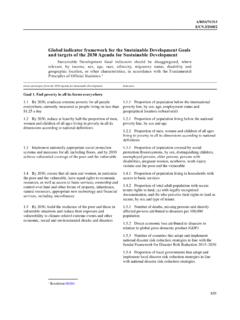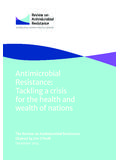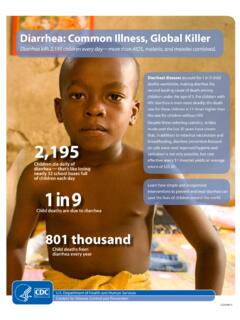Transcription of Annex 5. Tanzania - WHO
1 11 Annex 5. Tanzania Background Tanzania , situated on the eastern side of Africa, is a country faced with major challenges. Internal factors such as poor infrastructure, low education levels, poverty, and diseases exacerbate the extent of these challenges. The bold attempt, in the form of the Millennium Development Goals (MDG) set by the United Nations (UN), to eradicate poverty, mortality, and combat diseases remains important for countries striving to improve the overall state of wellness of their societies. The country has recognized the shortages of health professionals as impacting very negatively on its ability to make progress in achieving health-related MDGs. In an attempt to fill the gap of health professionals, Tanzania has implemented a system of mid-level health workers (MLHWs) in relation to specific health service needs. We review Tanzania s health statistics and analyze some of the leading health indicators to contextualize a consideration of the impact of MLHWs on health-related MDGs in the country.
2 An essential part of and what can be considered threshold conditions for any country s economic and social development is ensuring that its population has access to adequate health care services and facilities. Only half of the population (54%) has access to improved drinking water, while only 24% has access to improved sanitation facilities. As such, maternal mortality, child mortality, HIV/ aids , pneumonia, and malaria , are major issues that the health system faces, with malaria being the most common. Given the disease profile of this country, it appears that based on the most pressing health challenges ( malaria and HIV/ aids ), prevention and health promotion are the greatest health service needs. This clearly supports a more active role for lower level health workers, such as MLHWs, who could assist in carrying the more preventive and health-promoting load of more highly qualified medical practitioners.
3 The Tanzanian health system is decentralized, and framed most explicitly by its National Health The Tanzanian National Health Policy appears to be driven primarily by the objective to provide access to quality primary health care for all Explicitly linked to the health-related Millennium Development Goals (MDG) is the policy s identification of and focus on resources towards an essential health care package, which is an integrated collection of cost effective interventions that address the main diseases, injuries and risk factors in the Community health promotion and disease prevention through environmental sanitation and management of occupational health services is recognized as a key component. Provision of health care, particularly in rural areas and facilities, was adversely affected after the economic recession in the 1970s and 1980s, which resulted in an overall deterioration of health care services.
4 This led to the Tanzanian government introducing Cost-Sharing in 1993 and following that, instituting other financing options such as a National Health Insurance and a Community Health In general, the health services are heavily based on national government financing, with some tax-based funds through local government council tax collection and other The Community Health Fund (CHF) is viewed as an effective tool for mobilizing voluntary community involvement and participation in supporting their own health, whereas the Health Insurance Scheme is seen as a mechanism to ensure medical protection of employees in the formal sector. 1 12 Regardless of the context within which health care has to occur, fundamental to ensuring the health of the nation is the availability of appropriate numbers and quality of human resources for health. A country such as this, with a decentralized system of health care provision, requiring dispersed access to HRH, coupled with a burden of disease concentrated at the periphery of society, could benefit from the specific health service characteristics that MLHWs can provide.
5 Situational analysis of MLHW in Tanzania National HRH strategic plan and policy The Ministry of Health and Social Welfare is responsible for the governance and leadership of Human Resources for Health (HRH) as well as the human resources needs for the social services sector. The plan considers the status of HRH, the management thereof, and based on these aspects, projects future workforce requirements to suggest strategic interventions. Furthermore, it set out an implementation matrix, which facilitates the structures that need to be in place for the monitoring and evaluation of the plan. Lastly, a budget to support the implementation of the plan is offered. Tanzania s most recent policy relating to human resources in the health sector is its Human Resources for Health Strategic Plan 2008 The plan was developed through a multi-stakeholder process, which was also open to participation from various levels of health and social welfare sector stakeholders.
6 International organizations, such as the WHO, JICA and the Capacity Project, were extensively involved either through consultation or lending financial support. The creation of the plan was coordinated and led through the Human Resource Planning section that resides under the Ministry of Health and Social Welfare. The plan is set to be reviewed every year. The purpose of the plan is to provide proper planning, development, management and effective utilization of human resources. 2 The plan is driven by the realities of a high burden of disease accompanied by high level of incidence of non-communicable conditions such as cancer and malnutrition, within the context of extensive human resource shortages. This document sets out the extent of shortages and illustrates that in the public sector, these are most extensive at the lower level health facilities, and in the private sector to be most extensively experienced at the higher level health facilities.
7 Most importantly is the realization that major disease programs like HIV/ aids and malaria programs impose additional demands on the existing workforce without a concomitant consideration of the additional support and HRH needed to affect these There is no explicit consideration of the role and training of mid-level health workers in the policy. However, in the implementation matrix, which sets out the objectives of the plan and the activities linked to implementing these, there is a strategy to strengthen workforce practices, and to scale up enrollment and training of health workers . Here, there is mention of building a case to accommodate new and emerging health cadres, as well as the re-introduction of community health cadres in line with the primary health care focus. The HRH information system is not well Some information is gathered through the health management information system and professional bodies, but these data are very limited for the 13 purposes of informing decision-making and proper There are specific difficulties linked to a lack of co-ordination between different units and unreliability in certain instances of the HR data.
8 This is exacerbated by the lack of HR information specifically from the private sector, and the limited ability and skills to analyze demand and supply in order to inform forecasting. The issue that most negatively impacts the sector s ability to plan, manage, retain and appropriate educate current and future HRH, is primarily the poor system for HR information management, and secondarily, the difficulties current training institutions have in trying to match existing demand. The HRH Strategic Plan acknowledges the lack of retention strategies as one of the main factors negatively impacting on the recruitment and retention of all cadres. The increasingly dire impact of HIV/ aids on the workforce is acknowledged in the commitment to develop an HIV/ aids Workplace Program. MLHWs in Tanzania Neither the National Health Policy (2003), nor the Human Resources for Health Strategic Plan (2008), details the total numbers of each type of MLHW in Tanzania .
9 The HRH Strategic Plan does offer some consideration of the general HRH supply and demand information, using this to calculate staff shortages across different health facilities in the country. Rather, indications of the spread of MLHWs in Tanzania were found in a recent article by Munga & Maestad (2009), reproduced below. The table shows that the majority of health workers, as well as the main MLHWs (Clinical Officers (COs) and Assistant Medical Officers (AMOs)) are concentrated in the government sector, with the minority found in the private sector. The distribution of different levels of health provider cadres is much more equal in the private sector. Table 1: Distribution of health workers across cadres and sectors (%), Tanzania (n= 46 896) Cadre Government Private Voluntary Agencies Total Medical Officer Assistant Medical Officer Clinical Officer Nurse/Nurse-Midwife Medical Assistant Other Total Source: Munga & Maestad (2009) Dovlo (2004) estimates the average annual production of MLHWs in Tanzania to be roughly 300 Clinical officers, and 40 Assistant Medical Officers in comparison to roughly 50 Medical Officers/Doctors per year.
10 Mckinsey & Co (2009), through a health workforce pyramid, indicate the Tanzanian health system to have 400 specialists, 940 medical officers, 1400 assistant medical officers, 6900 clinical officers, 5500 registered nurses, 3580 diagnostic and support staff (includes 1090 laboratory workers, 340 pharmacy workers and 2150 other healthcare workers) and 7070 enrolled nurses (at that time the numbers of clinical assistants were not yet available as the training for these cadres only began in 2008). It is quite a challenge to attempt a situational analysis of MLHWs in Tanzania because, as mentioned, the existing HRH information system is not well coordinated and An evaluation of the impact of MLHWs in Tanzania has to investigate the role and contribution specifically of COs and AMOs. In Tanzania , COs can provide clinical medicine, and they were the starting cadre, but were upgraded to an "assistant medical officer" with a considerably widened scope of practice.













